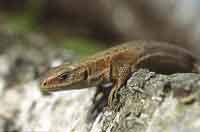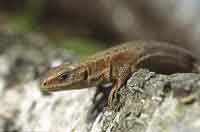Global warming cited as reason that may lead to the demise of viviparous lizards that give birth to live young.
Click image to enlarge Lacerta vivipara. Photo by Marek Szczepanek/Wikipedia |
In 50 years, global warming could lead to the extinction of lizards that reproduce via viviparity, according to the paper "The evolution of viviparity opens opportunities for a lizard radiation but drives it into a climatic cul-de-sac" published by University of Lincoln researchers in England.
Viviparous lizards are often found in cold environments and evolved to carry their eggs internally until they hatched, enabling the females to give birth to live young. This evolution is said to have occurred in an effort for the lizards to succeed in colder climates. It was a key trait to their success in climates that other cold blooded animals could not readily survive in. But the warming of the earth could be a factor that could lead to the extinction of this family of lizard species.
"When reptiles initially moved to colder areas they needed to evolve emergency measures to succeed in these harsh places, and we believe viviparity is one of these key measures, Lincoln researcher Dr. Daniel Pincheira-Donoso said in a press release put out by the university. "However, this transition is mostly one-directional and unlikely to be reversed. Rapid changes in the environment's temperature would demand rapid re-adaptations to secure the species' survival."
Want to Learn More?
Pincheira-Donoso, of the School of Life Sciences at the university and the lead author of the paper, his colleagues and researchers with the University of Exeter studied the hypothesis that the evolutionary migrations of Liolaemus lizards into cold climates was possible to their evolution away from egg laying and to giving birth to live young. However, once the species establishes viviparity, they become restricted to colder climates. The scientists determined that the lizard species could become extinct in the next several decades due to higher temperatures in the areas in which these lizards can currently be found today. They cite global warming as the main contributing factor in that it would reduce the area in which these lizards currently thrive.


